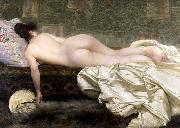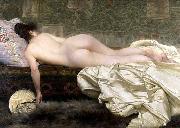
Oil On
Canvas, Real Flavor of Old Masters
|
Fernand Khnopff
|
|||
|
|
|||
| 1858-1921 Belgian Fernand Khnopff Gallery Fernand Khnopff was born to a wealthy family that was part of the high bourgeoisie for generations. Khnopff's ancestors had lived in Flanders since the early 17th-century but were of Austrian and Portuguese descent. Most male members of his family had been lawyers or judges, and young Fernand was destined for a juridical career. In his early childhood (1859-1864) he lived in Bruges where his father was appointed Substitut Du Procureur Du Roi. His childhood memories of the medieval city of Bruges would play a significant role in his later work. In 1864 the family moved to Brussels. To please his parents he went to law school at the Free University of Brussels (now divided into the Universite Libre de Bruxelles and the Vrije Universiteit Brussel) when he was 18 years old. During this period he developed a passion for literature, discovering the works of Baudelaire, Flaubert, Leconte de Lisle and other mostly French authors. With his younger brother Georges Khnopff - also a passionate amateur of contemporary music and poetry - he started to frequent Jeune Belgique ("Young Belgium"), a group of young writers including Max Waller, Georges Rodenbach, Iwan Gilkin and Emile Verhaeren. Khnopff left University due to a lack of interest in his law studies and began to frequent the studio of Xavier Mellery, who made him familiar with the art of painting. On the 25th of October 1876 he enrolled for the Cours De Dessin Apres Nature ("course of drawing after nature") at the Academie Royale des Beaux-Arts en Bruxelles. At the Academie, his most famous fellow student was James Ensor, whom he disliked from the start. Between 1877 and 1880 Khnopff made several trips to Paris where he discovered the work of Delacroix, Ingres, Moreau and Stevens. At the Paris World Fair of 1878 he became acquainted with the oeuvre of Millais and Burne-Jones. During his last year at the Acad??mie in 1878-1879 he neglected his classes in Brussels and lived for a while in Passy, were he visited the Cours Libres of Jules Joseph Lefebvre at the Acad??mie Julian. | |||
|
|
|||
|
|
Study of A woman new10/Fernand Khnopff-595975.jpg Painting ID:: 34941 Visit European Gallery |
mk98 c.1890-1892 Red chalk and blue highlights on paper 20.5x14.5 | |
Height Width |
INS/CM |
||
|
X |
|
||
|
|
|||
|
Rodolfo Amoedo
|
|||
|
|
|||
| (born in Salvador, Bahia on December 11, 1857; died in Rio de Janeiro on May 31, 1941) was a Brazilian history painter. He began his career as an artist in 1873 as a student of Victor Meirelles. In 1878 he won the first prize at the Brazilian Academy, which allowed him to travel to Paris, where he lived from 1879 to 1887 studying at the École des Beaux Arts. He was a pupil of Alexandre Cabanel and also worked with Paul-Jacques-Aime Baudry. He was a professor and later director of the Brazilian Academy, renamed School of Fine Arts ou Escola Nacional de Belas Artes at the fall of the Brazilian Empire. His students include Eliseu Visconti. He died forgotten and so poor his friends had to help the widow pay for his funeral. His paintings still hang at the National Museum Museu Nacional de Belas Artes in Rio de Janeiro. | |||
|
|
|||
|
|
Study of a woman new24/Rodolfo Amoedo-565664.jpg Painting ID:: 81634 Visit European Gallery |
Date 1884(1884) Medium Oil on canvas Dimensions 150.5 x 200 cm (59.3 x 78.7 in) cjr | |
Height Width |
INS/CM |
||
|
X |
|
||
|
|
|||
|
Rodolfo Amoedo
|
|||
|
|
|||
| (born in Salvador, Bahia on December 11, 1857; died in Rio de Janeiro on May 31, 1941) was a Brazilian history painter. He began his career as an artist in 1873 as a student of Victor Meirelles. In 1878 he won the first prize at the Brazilian Academy, which allowed him to travel to Paris, where he lived from 1879 to 1887 studying at the École des Beaux Arts. He was a pupil of Alexandre Cabanel and also worked with Paul-Jacques-Aime Baudry. He was a professor and later director of the Brazilian Academy, renamed School of Fine Arts ou Escola Nacional de Belas Artes at the fall of the Brazilian Empire. His students include Eliseu Visconti. He died forgotten and so poor his friends had to help the widow pay for his funeral. His paintings still hang at the National Museum Museu Nacional de Belas Artes in Rio de Janeiro. | |||
|
|
|||
|
|
Study of a woman new25/Rodolfo Amoedo-368768.jpg Painting ID:: 85596 Visit European Gallery |
1884(1884) Medium Oil on canvas Dimensions 150.5 x 200 cm (59.3 x 78.7 in) cyf | |
Height Width |
INS/CM |
||
|
X |
|
||
|
|
|||









